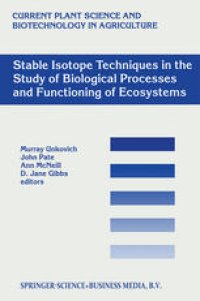
Ebook: Stable Isotope Techniques in the Study of Biological Processes and Functioning of Ecosystems
Author: Todd E. Dawson Paul D. Brooks (auth.) Murray Unkovich John Pate Ann McNeill D. Jane Gibbs (eds.)
- Tags: Plant Sciences, Plant Physiology, Soil Science & Conservation, Freshwater & Marine Ecology
- Series: Current Plant Science and Biotechnology in Agriculture 40
- Year: 2001
- Publisher: Springer Netherlands
- Edition: 1
- Language: English
- pdf
In the last two decades technological advances in isotope ratio mass spectrometry have been very rapid, opening up new possibilities for analysis of biological and environmental materials. The new instrumentation has facilitated faster analysis of samples via automated sample preparation and multi-isotope analysis of single samples, resulting in considerable cost savings, and enabling access to isotope analysis for many more researchers. These changes are reflected in the rapidly growing international literature on stable isotopes. While there have been some excellent books and review papers aimed at interpreting isotope signals in biology and environmental science, there have been fewer attempts to provide practical tools for researchers making forays into this exciting new arena. This book aims to address this inadequacy by providing a set of practical guidelines for the application of a range of novel and well proven stable isotope techniques to the fields of plant physiological ecology, agriculture, marine ecology and palaeoecology. The book is the outcome of a weeklong workshop held under the auspices of the Cooperative Research Centre for Legumes in Mediterranean Agriculture (CLIMA 1992 - 2000) at The University of Western Australia and the CSIRO Floreat Laboratories, Perth, Western Australia, in February 1999. The workshop was designed to provide practical tools and experiences for researchers and students concerned with how one goes about using stable isotopes in field investigations.
This book has a very strong practical orientation, telling readers what methodologies are available using stable isotopes, how studies should be designed and executed to maximise effectiveness and incisiveness in terms of data obtained and outcomes in terms of understanding events and processes in plant and ecosystem functioning.
The readership is very much aimed toward postgraduates with good knowledge of general biological principles and underlying chemical and physical processes. Pre-existing knowledge of or experience in application and assay of stable isotopes is not required. The stable isotope research field is one of the most rapidly growing areas of ecophysiology and techniques using stable isotopes comprise an ever increasing component of research programs of university postgraduates and a wide range of agencies conducting environmental monitoring and rehabilitation programs. The book is tailor-made for such an audience.
This book has a very strong practical orientation, telling readers what methodologies are available using stable isotopes, how studies should be designed and executed to maximise effectiveness and incisiveness in terms of data obtained and outcomes in terms of understanding events and processes in plant and ecosystem functioning.
The readership is very much aimed toward postgraduates with good knowledge of general biological principles and underlying chemical and physical processes. Pre-existing knowledge of or experience in application and assay of stable isotopes is not required. The stable isotope research field is one of the most rapidly growing areas of ecophysiology and techniques using stable isotopes comprise an ever increasing component of research programs of university postgraduates and a wide range of agencies conducting environmental monitoring and rehabilitation programs. The book is tailor-made for such an audience.
Content:
Front Matter....Pages i-ix
Fundamentals of Stable Isotope Chemistry and Measurement....Pages 1-18
Carbon Isotope Discrimination and Plant Water-Use Efficiency....Pages 19-36
Extraction and Analysis of Plant Water for Deuterium Isotope Measurement and Application to Field Experiments....Pages 37-55
The Use of Stable Isotopes of Water for Determining Sources of Water for Plant Transpiration....Pages 57-89
What do ?15N Signatures tell Us about Nitrogen Relations in Natural Ecosystems?....Pages 91-101
Assessing N2 Fixation in Annual Legumes using 15N Natural Abundance....Pages 103-118
The Use of 15N to study Biological Nitrogen Fixation by Perennial Legumes....Pages 119-144
Source/Sink Interactions in Crop Plants....Pages 145-165
Use of Enriched 15N Sources to study Soil N Transformations....Pages 167-194
Stable Isotope Techniques using Enriched 15N and 13C for Studies of Soil Organic Matter Accumulation and Decomposition in Agricultural Systems....Pages 195-218
Source Identification in Marine Ecosystems....Pages 219-245
?13C as an Indicator of Palaeoenvironments....Pages 247-279
Back Matter....Pages 281-293
This book has a very strong practical orientation, telling readers what methodologies are available using stable isotopes, how studies should be designed and executed to maximise effectiveness and incisiveness in terms of data obtained and outcomes in terms of understanding events and processes in plant and ecosystem functioning.
The readership is very much aimed toward postgraduates with good knowledge of general biological principles and underlying chemical and physical processes. Pre-existing knowledge of or experience in application and assay of stable isotopes is not required. The stable isotope research field is one of the most rapidly growing areas of ecophysiology and techniques using stable isotopes comprise an ever increasing component of research programs of university postgraduates and a wide range of agencies conducting environmental monitoring and rehabilitation programs. The book is tailor-made for such an audience.
Content:
Front Matter....Pages i-ix
Fundamentals of Stable Isotope Chemistry and Measurement....Pages 1-18
Carbon Isotope Discrimination and Plant Water-Use Efficiency....Pages 19-36
Extraction and Analysis of Plant Water for Deuterium Isotope Measurement and Application to Field Experiments....Pages 37-55
The Use of Stable Isotopes of Water for Determining Sources of Water for Plant Transpiration....Pages 57-89
What do ?15N Signatures tell Us about Nitrogen Relations in Natural Ecosystems?....Pages 91-101
Assessing N2 Fixation in Annual Legumes using 15N Natural Abundance....Pages 103-118
The Use of 15N to study Biological Nitrogen Fixation by Perennial Legumes....Pages 119-144
Source/Sink Interactions in Crop Plants....Pages 145-165
Use of Enriched 15N Sources to study Soil N Transformations....Pages 167-194
Stable Isotope Techniques using Enriched 15N and 13C for Studies of Soil Organic Matter Accumulation and Decomposition in Agricultural Systems....Pages 195-218
Source Identification in Marine Ecosystems....Pages 219-245
?13C as an Indicator of Palaeoenvironments....Pages 247-279
Back Matter....Pages 281-293
....